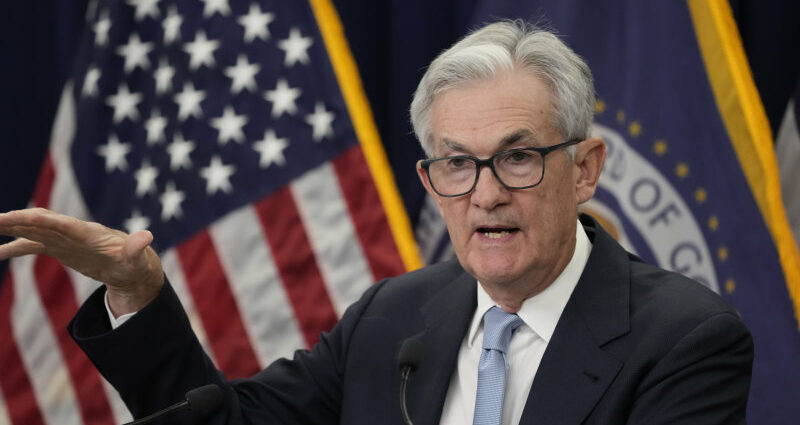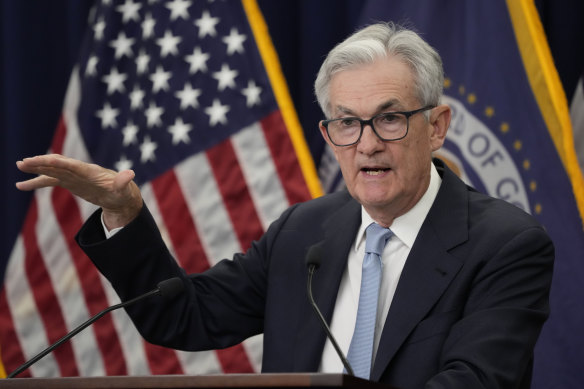Save articles for later
Add articles to your saved list and come back to them any time.
At face value, the larger-than-expected fall in the US inflation rate to its lowest level in almost two years should have been welcomed by financial markets. That it wasn’t points to the problem shared by all the major central banks in the inflationary aftermath of the pandemic.
The headline rate of US inflation fell from an annual rate of 6 per cent in February to 5 per cent in March, its lowest rate since May 2021. That beat expectations that it would come in at 5.2 per cent.
“Core” inflation – with volatile energy and food costs stripped out – however rose from 5.5 per cent in February to 5.6 per cent. While that was in line with expectations, it marks the first time in this cycle that core inflation has been higher than the headline rate and underscores how “sticky” the underlying levels of inflation are.
There’s a near-conviction in the markets that the inflation data has probably made the case for one rate hike for the Fed.Credit: AP
Wall Street’s stocks edged down, and bond yields also fell in response to not just the inflation data, but also the release of Federal Reserve Board minutes from its meeting last month that revealed its officials expect there to be a “mild” recession in the US, starting later this year.
Despite that prediction, there is a near-conviction in the markets that the inflation data has probably made the case for one more 25 basis point increase in the federal funds rate (equivalent to the Reserve Bank’s cash rate) when the Fed’s Open Market Committee next meets on May 3.
It is possible, bordering on probable, that if the Fed does raise rates again next month and lifts its target for the federal funds rate from its current range of 4.75 per cent to 5 per cent, it will be the tenth and last of the post-pandemic cycle.
There are reasons why the Fed contemplated a 50 basis point increase last month, but decided to go with a 25 basis point rise instead, and why the market is almost convinced that both core inflation and US rates will be falling in the second half of the year.
The US bank failures were a warning sign that the tightening of conditions was starting to break things. There is a risk that if policymakers tighten conditions much more, more and bigger things might break.
The Fed backed away from the 50 basis point option because, as it met last month, the US banking system was stressed by the failure of several relatively small banks, most notably the Silicon Valley and Signature banks. (The turmoil that created was a factor in the RBA’s decision to pause its rate-hiking cycle this month).
While those failures have been dealt with, along with the flow-on effect they had on global banking giant Credit Suisse, which was forced into a merger with arch rival UBS after runs on its deposit base, there has been continued fallout.
There has been a significant loss of deposits from the smaller players in the banking system, with funds flowing to money market funds and the big Wall Street banks. That will impact the willingness and capacity of the smaller banks to lend.
Indeed, it might already be doing so.
In the immediate aftermath of the bank failures, US bank lending fell by more than $US100 billion ($149 billion) within a fortnight. Smaller regional and community banks are at the heart of bank lending to the real economy in the US. They account for more than half of all commercial and retail lending, including the vast majority of commercial property lending.
If those smaller banks pull back or are forced to cut back their lending due to a combination of increased risk-aversion and their own reduced (and higher-cost) funding bases, the reduced availability of credit will slow activity and growth within the US economy. It could by itself push the economy into recession.
If the impact of the bank failures was a key factor for the Fed’s decision-making last month, it will remain one when its policymakers meet next month.
The US central bank will be wary of increasing the pressure on the banking system generated by the long cycle of rising interest rates, and because of its quantitative tightening program (allowing $US95 billion a month of the bonds and mortgages it had bought to inject liquidity into the system and lower rates in response to the pandemic to mature without reinvestment), the continued withdrawal of liquidity and tightening of credit conditions.
It will also be mindful that the biggest contributors to core inflation are what the Americans describe as “shelter” costs, or house prices, rents and hotel rates. There are considerable lags between changes in those costs and when they show up in the inflation data.
Those costs were still rising, according to the March data, but at a slower rate and anecdotal evidence suggests that they might have begun falling.
Recent data on manufacturing and employment also show a weakening of activity and, while there is still strong growth in employment, wage pressures appear to be subsiding.
The supply chain bottlenecks that helped ignite inflation rates throughout the developed world have also all but disappeared, with shipping rates almost back to their pre-pandemic levels.
In other words, there are many signs that the most aggressive monetary policies in 40 years have broken the back of the worst inflation in 40 years and that the inflation rate will probably continue to trend down through the rest of this year, with or without another push from the Fed.
OPEC’s recent shock decision to cut production by 1.2 million barrels a day from next month, which has already pushed up oil prices by about $US7 a barrel – an increase that will flow into petrol/gasoline prices – will have a near-term effect on headline inflation rates around the world, but could also be self-defeating, given that it will hit already-slowing economies.
While the US inflation rate, headline or core, remains well above the Fed’s target of 2 per cent and there is unlikely to be a sufficient acceleration in disinflation to get within reach of that target this year, it is apparent – as it is here – that monetary policies have gained traction. The inflationary heat is gradually cooling even before the “mild” recession that the Fed envisages.
Whether there is a mild recession in the US or elsewhere depends on how finely the Fed and other central banks can judge their moments and their decisions.
The US bank failures were a warning sign that the tightening of conditions was starting to break things. There is a risk that if policymakers tighten conditions much more, more and bigger things might break – and the Fed would no longer be envisaging a mild recession, but something far more destructive.
The Business Briefing newsletter delivers major stories, exclusive coverage and expert opinion. Sign up to get it every weekday morning.
Most Viewed in Business
From our partners
Source: Read Full Article
-
The RBA has taken a breather, but that’s no reason to relax
-
U.S. Trade Deficit Narrows Amid Steep Drop In Imports In July
-
RHI Magnesita Expects Acquisitions To Boost Annual Earnings; Lifts Adj. EBITA Outlook
-
French Consumer Confidence Improves Slightly In April
-
Philips Q1 Loss Widens, Adj. EBITA Rise; Says Confident Of FY23; Stock Climbs


